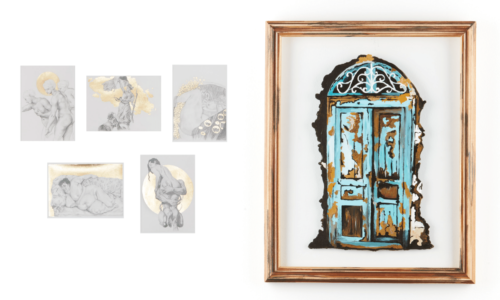The Sancta community congratulates Meg Taylor and Gabby Boshier for their amazing submissions to this year’s Palladian Cup art competition.
The art competition comprises one of the seven categories of The Palladian Cup, which is a highly anticipated annual competition between the six residential colleges of The University of Sydney.
Meg Taylor’s artwork, The Passive Muse, took out first place for her “excellent handle of medium and rendition of Masters works” and “engagement with art history”. This year’s theme was ‘on the other side’ and the judges were Tesha Malott, Paul Williams and Zan Wimberley.
The Passive Muse by Meg Taylor

Artist Statement: “On the other side” of art history lies the female muse, the passive figure onto which society can project its feminine ideals and standards. Art history is classically androcentric, centralising male artists and muses, and depicting masculine historical perspectives. Female figures are commodified through their representation throughout art history. The “other” perspective in art history, (the perspectives of women) is most interesting in relation to its documentation largely through the eyes of male artists. My work focuses on the monetary value placed on the nude female, represented in the gold leaf. This reward is then reaped by the male artist, emphasising the vulnerability of women throughout history that the artists so clearly capture. This work is comprised of five famous nude portraits of women painted by men throughout art history: “The Three Graces,” Raphael (1503), “Liberty Leading the People,” Eugene Delacroix (1830), “Danaë,” Gustav Klimt (1907), “Benefits of Supervisor Sleeping,” Lucian Freud (1995) and “Pieta Occulata,” Roberto Ferri (2018).
No, impassable. Nothing’s impossible by GabBY Boshier

Artist Statement: A simple warn and weathered door, rich with French blues, hinting to a flavoured history. Painted with Acrylic on Perspex, the slightly ajar door attracts curiosity and intrigue, if you could push the door a little further would you find out what was on the other side? Or, if you look closely enough you may be able to see straight through. The use of Perspex as the canvas allows you to see what is ‘on the other side’ contrary to the image of the closed door, encouraging the viewer to expand their imagination and render possibilities of what could be ‘on the other side’. The juxtaposition of the closed door and the clear Perspex forms an intriguing tension between curiosity and knowledge. This painting is for the endless possibilities of one’s imagination.

